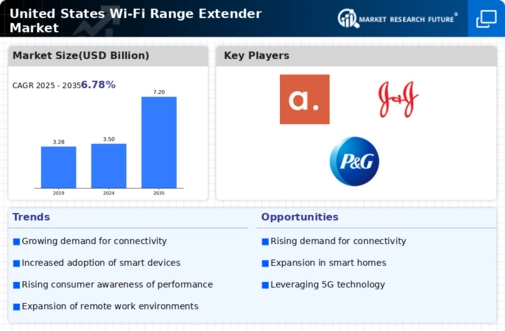The wi fi range extender market exhibits a dynamic competitive landscape characterized by rapid technological advancements and evolving consumer demands. Key players such as Netgear (US), TP-Link (US), and Linksys (US) are at the forefront, each adopting distinct strategies to enhance their market positioning. Netgear (US) emphasizes innovation through the development of high-performance extenders that cater to the increasing demand for seamless connectivity in smart homes. TP-Link (US), on the other hand, focuses on affordability and accessibility, offering a range of products that appeal to budget-conscious consumers. Linksys (US) positions itself as a premium brand, targeting tech-savvy users with advanced features and robust performance. Collectively, these strategies contribute to a moderately fragmented market, where competition is driven by technological differentiation and customer-centric approaches.
In terms of business tactics, companies are increasingly localizing manufacturing to mitigate supply chain disruptions and enhance responsiveness to market demands. This trend is particularly evident in the US, where firms are optimizing their supply chains to ensure timely delivery and cost efficiency. The competitive structure remains moderately fragmented, with several players vying for market share, yet the influence of major companies is palpable as they set benchmarks for quality and innovation.
In November 2025, Netgear (US) launched its latest range extender, which integrates AI-driven features to optimize network performance based on user behavior. This strategic move not only enhances user experience but also positions Netgear (US) as a leader in smart home technology, potentially attracting a broader customer base seeking advanced connectivity solutions. The introduction of AI capabilities signifies a shift towards more intelligent devices that adapt to user needs, thereby reinforcing Netgear's competitive edge.
In October 2025, TP-Link (US) announced a partnership with a leading telecommunications provider to bundle its range extenders with internet service plans. This collaboration aims to enhance customer acquisition and retention by providing consumers with a comprehensive connectivity solution. By aligning with a major service provider, TP-Link (US) is likely to increase its market penetration and brand visibility, which could lead to a significant uptick in sales.
In September 2025, Linksys (US) unveiled a new line of extenders designed specifically for gaming enthusiasts, featuring low-latency performance and enhanced bandwidth management. This targeted approach not only caters to a niche market but also underscores Linksys's commitment to innovation and customer satisfaction. By focusing on the gaming segment, Linksys (US) is likely to differentiate itself from competitors and solidify its reputation as a premium brand in the wi fi range extender market.
As of December 2025, the competitive trends in the wi fi range extender market are increasingly defined by digitalization, sustainability, and the integration of AI technologies. Strategic alliances are becoming more prevalent, as companies recognize the value of collaboration in enhancing product offerings and expanding market reach. Looking ahead, competitive differentiation is expected to evolve, with a pronounced shift from price-based competition to a focus on innovation, technological advancements, and supply chain reliability. This transition may redefine market dynamics, compelling companies to invest in R&D and strategic partnerships to maintain their competitive positions.














Leave a Comment